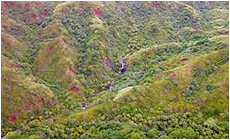Research Programs
SURFACE WATER AND WATERSHEDS
Watershed Management Program
In his 1998 State of the Union Address, President Clinton announced a major new national Clean Water Initiative, the Clean Water Action Plan (CWAP). This initiative aims to achieve clean waters by encouraging federal and nonfederal agencies, other organizations and interested citizens to work in a collaborative manner to restore our highest priority watersheds. The federal government has committed to contributing its technical and financial resources to the implementation of the plan. Guam responded to this federal initiative by convening a work group, the Water Planning Committee (WPC), which is made up of representatives from fourteen agencies and interested organizations. The WPC completed an assessment of the island´s watersheds and selected three, the Northern, Ugum and Talofofo, as its highest priority watersheds due to their value as drinking water resources.
In 1987, the Pohnpei state legislature passed the Pohnpei Watershed Forest Reserve and Mangrove Protection Act in which close to 5,000 hectares (or 12,500 acres) of upland forest was set aside as a protected Watershed Forest Reserve. The purpose of this act was to halt the degradation of the interior forests from road construction and population encroachment as well as to protect the watershed and water supply for the island´s population. However, when surveyors attempted to mark the boundary of this reserve, suspicious and angry villagers with machetes and guns turned them back. With this single act, the story of watershed management on Pohnpei began and continues to unfold today.
WERI researchers have undertaken several projects for developing a watershed management strategy for Guam and the Federated States of Micronesia. In Guam, researchers assessed the existing natural resources of the Ugum watershed and identified the areas that have potential to contribute pollution into the streams and eventually into the coastal areas within the Ugum.
In Pohnpei island researchers are developing a data base for three watersheds with different degree of man´s activities. Data includes rainfall, stream flow, turbidity, land clearing for agriculture, road construction, and housing development. The overall objective of this project is to study the impact of man´s activities on the quality of the water in the watershed and make recommendations to reduce the impact of these activities.
For more information send and email to Dr. Khosrowpanah: khosrow(weri)uguam.uog.edu?subject=Watershed Management Program - WeriGuam.org
Back to top ^








